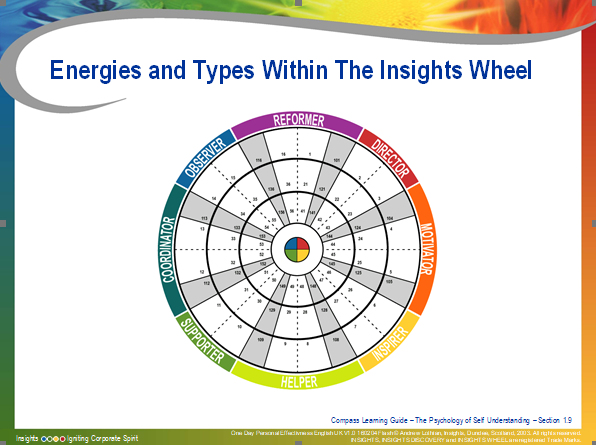In last week's blog, I spoke about the importance of understanding and being aware of your own personal communication style. Being a qualified practitioner in psychometric profiling, I can say without fear of contradiction, that it has been one of the most powerful tools that I have used in my consulting and sales profession.
Not only does Insights Discovery make you aware of your own observable behaviour and temperament, it also provides you with insights into other people's personalities and how they like to be communicated to.
To repeat what I said..."that of which I am aware, gives me control; that of which I am not aware, controls me".
What we explained in last week's blog was that everyone has a "most and least" preference or energy in the way one communicates. In other words, every one of us has preferences and we lead with our first, followed by second, third and fourth energy. I explained in my case, the following combination applies:
1. Sunshine yellow... Say something uplifting and involve me!
2. Earth green... Be empathetic, show you care about me!
3. Fiery red... Please do things quickly, be brief, be bright, be gone!
4. Cool blue... Okay, if you have to give me the fine detail, do so!
Of course when you get into the fine detail of your profile, these four energies are divided into eight. Furthermore, applying concentric circles as set out in the Illustration 1 below, it positions you in one of 72 locations. This is why everyone's profile is unique and the words and descriptors that are pulled from the database of hundreds of thousands of such words and descriptors, means that no two profiles are ever the same.
Research indicates that the profile is c.93% accurate, and frankly, scary! "Have you been speaking to my family?" is a question I am frequently asked having debriefed people on their profiles.
Illustration 1
So how do we apply this to sales and business development?
As already mentioned, you must firstly understand yourself and be aware of your strengths on which to build and weaknesses to eliminate. In addition, your customers and prospects, instinctively see you this way as the well, even though they may not be proficient in psychometric profiling. It's how you come across to them.
Take the sales process as having six stages, namely,
1. preplanning sales meetings
2. uncovering and diagnosing client needs
3. presenting your solution and proposing
4. dealing with objections
5. closing the sale
6. following up and after sales service
As an example, let's apply my preferences (Y, G, R and B) referred to above. In other words, I lead with yellow energy, followed by green, then red, and finally blue energy.
Let's apply these four colour energies to the six stages above. By nature, I should be good at certain aspects, and potentially weak in others. So what are these?
1. Preplanning sales meetings
I score highly in building trust (green) and getting appointments because of my (yellow) extrovert style, however, I may need to work harder on being clear on objectives (red) and going into the fine detail of researching clients (blue)
2. Uncovering and diagnosing client needs
I score well in encouraging people to think about the possibilities (yellow) and also creating business opportunities (yellow), however, listening and questioning (blue/green) are areas that are possibly in need of attention. I have really had to work on this aspect and would not have been aware of it, but for Insights.
3. Presenting your solution and proposing
Enthusiastic presentations (yellow) and understanding needs (green), come easy to me. If I am not careful, my proposals can wander and not be focused, relevant (red), and accurate (blue).
4. Dealing with objections
Yellow energy people like myself, are pretty good at persuasion and meeting the concerns of others (green), while the direct handling of objections (red) and getting into the fine detail of proposal clarity (blue) can be weak.
5. Closing the sale
I have no problem with being flexible when negotiating (green) and fairly okay when in (red extrovert) AFTO-mode (asking for the order)! Often minimising the risks are not handled in a true blue fashion, in other words, failing to get into the detail of assuring the person that this proposal will be fine and your needs will be met (blue). I often say...it will be fine, trust me and blue energy people don't like this!
6. Following up and after sales service
Finally, my relationship maintenance and keeping in contact (green) are pretty good, however, planning for the future and being clear about what I can deliver for the client is something I have to be constantly aware of (blue).
In summary, what I have done in my sales process is become highly aware of the potential/possible weaknesses of how I sell. I have worked on these and turned them into strengths.
Does this make sense to you? Good! So why not get to work on understanding more about your personal selling style and behaviour... and learn from it.
You will not be disappointed (yellow)! Trust me (green)!!
Contact us to discuss your corporate and executive coaching requirements:

































